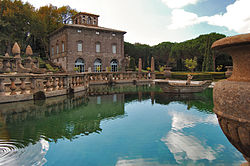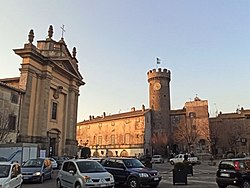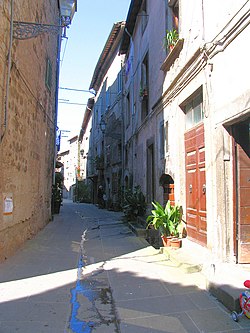Villa Farnese

The Villa Farnese, also known as Villa Caprarola, is a pentagonal mansion in the town of Caprarola in the province of Viterbo, Northern Lazio, Italy, approximately 50 kilometres (31 mi) north-west of Rome, originally commissioned and owned by the House of Farnese. A property of the Republic of Italy, Villa Farnese is run by the Polo Museale del Lazio. This villa is not to be confused with two similarly-named properties of the family, the Palazzo Farnese and the Villa Farnesina, both in Rome. The Villa Farnese is situated directly above the town of Caprarola and dominates its surroundings. It is a massive Renaissance and Mannerist construction, opening to the Monte Cimini, a range of densely wooded volcanic hills. It is built on a five-sided plan in reddish gold stone; buttresses support the upper floors. As a centerpiece of the vast Farnese holdings, Caprarola was always an expression of Farnese power, rather than a villa in the more usual agricultural or pleasure senses.
Excerpt from the Wikipedia article Villa Farnese (License: CC BY-SA 3.0, Authors, Images).Villa Farnese
Viale Regina Margherita,
Geographical coordinates (GPS) Address Nearby Places Show on map
Geographical coordinates (GPS)
| Latitude | Longitude |
|---|---|
| N 42.329997222222 ° | E 12.231997222222 ° |
Address
Viale Regina Margherita
01032
Lazio, Italy
Open on Google Maps








